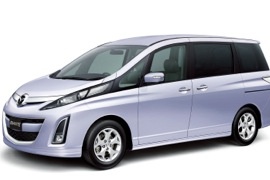MAZDA Biante Models/Series Timeline, Specifications & Photos
First production year: 2008
Engines: Gasoline
Body style: Van
Mazda introduced the Biante for the Japanese market in 2008 and built it on top of the same platform used by the Mazda5 MPV.
Developed just before the world economic crisis, the Biante aimed at customers looking for a minivan that could provide a sporty look and a spacious interior. It didn't even try to offer the car in more markets and planned just a 3,000 sales target for the MPV.
The car was developed during the Zoom-Zoom design language of the Japanese carmaker. It followed the same ideas as the Miata, the 3, and the 6. Thus, at the front, the car featured high-mounted headlights swept back toward the thick A-pillars. The front fascia featured a shield-like grille crossed by a slat that supported the license plate. The foglamps were placed in the tall and slim side clusters that flanked the grille. Biante's high-roof profile featured blacked-out pillars that created the illusion of a long window from front to back. Thanks to the standard sliding rear doors, the passengers could easily get in and out of the vehicle.
Inside, the eight-seat minivan featured high-mounted bucket seats at the front and two benches for three passengers in the back. Mazda stepped up the game in the otherwise dull MPV segment by creating a sliding middle row. That solution allowed the passengers to get more legroom when there was no one seated in the last row. Above the dash panel, Mazda designers installed a center-mounted instrument cluster covered by a long and curved visor. Atop the center stack, the carmaker added the infotainment screen just above the gear selector and the HVAC buttons.
Mazda offered the Biante exclusively with automatic transmissions. The AWD versions received a four-speed auto, while the FWD ones were fitted with five-speed automatic transmissions with manual override.
